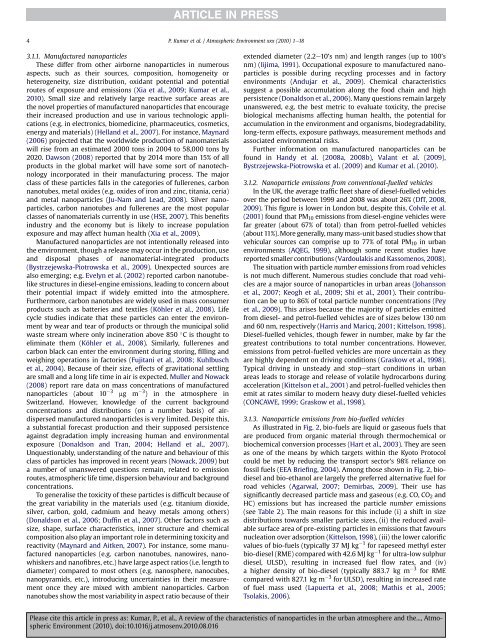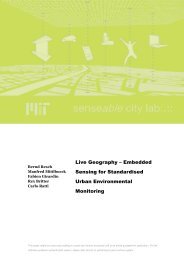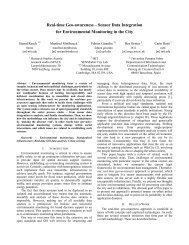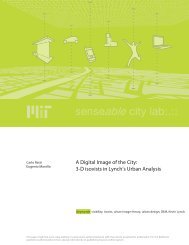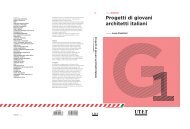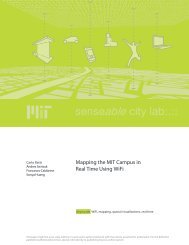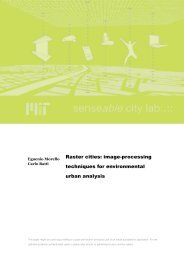A review of the characteristics of nanoparticles in the urban ...
A review of the characteristics of nanoparticles in the urban ...
A review of the characteristics of nanoparticles in the urban ...
You also want an ePaper? Increase the reach of your titles
YUMPU automatically turns print PDFs into web optimized ePapers that Google loves.
4<br />
P. Kumar et al. / Atmospheric Environment xxx (2010) 1e18<br />
3.1.1. Manufactured <strong>nanoparticles</strong><br />
These differ from o<strong>the</strong>r airborne <strong>nanoparticles</strong> <strong>in</strong> numerous<br />
aspects, such as <strong>the</strong>ir sources, composition, homogeneity or<br />
heterogeneity, size distribution, oxidant potential and potential<br />
routes <strong>of</strong> exposure and emissions (Xia et al., 2009; Kumar et al.,<br />
2010). Small size and relatively large reactive surface areas are<br />
<strong>the</strong> novel properties <strong>of</strong> manufactured <strong>nanoparticles</strong> that encourage<br />
<strong>the</strong>ir <strong>in</strong>creased production and use <strong>in</strong> various technologic applications<br />
(e.g. <strong>in</strong> electronics, biomedic<strong>in</strong>e, pharmaceutics, cosmetics,<br />
energy and materials) (Helland et al., 2007). For <strong>in</strong>stance, Maynard<br />
(2006) projected that <strong>the</strong> worldwide production <strong>of</strong> nanomaterials<br />
will rise from an estimated 2000 tons <strong>in</strong> 2004 to 58,000 tons by<br />
2020. Dawson (2008) reported that by 2014 more than 15% <strong>of</strong> all<br />
products <strong>in</strong> <strong>the</strong> global market will have some sort <strong>of</strong> nanotechnology<br />
<strong>in</strong>corporated <strong>in</strong> <strong>the</strong>ir manufactur<strong>in</strong>g process. The major<br />
class <strong>of</strong> <strong>the</strong>se particles falls <strong>in</strong> <strong>the</strong> categories <strong>of</strong> fullerenes, carbon<br />
nanotubes, metal oxides (e.g. oxides <strong>of</strong> iron and z<strong>in</strong>c, titania, ceria)<br />
and metal <strong>nanoparticles</strong> (Ju-Nam and Lead, 2008). Silver <strong>nanoparticles</strong>,<br />
carbon nanotubes and fullerenes are <strong>the</strong> most popular<br />
classes <strong>of</strong> nanomaterials currently <strong>in</strong> use (HSE, 2007). This benefits<br />
<strong>in</strong>dustry and <strong>the</strong> economy but is likely to <strong>in</strong>crease population<br />
exposure and may affect human health (Xia et al., 2009).<br />
Manufactured <strong>nanoparticles</strong> are not <strong>in</strong>tentionally released <strong>in</strong>to<br />
<strong>the</strong> environment, though a release may occur <strong>in</strong> <strong>the</strong> production, use<br />
and disposal phases <strong>of</strong> nanomaterial-<strong>in</strong>tegrated products<br />
(Bystrzejewska-Piotrowska et al., 2009). Unexpected sources are<br />
also emerg<strong>in</strong>g; e.g. Evelyn et al. (2002) reported carbon nanotubelike<br />
structures <strong>in</strong> diesel-eng<strong>in</strong>e emissions, lead<strong>in</strong>g to concern about<br />
<strong>the</strong>ir potential impact if widely emitted <strong>in</strong>to <strong>the</strong> atmosphere.<br />
Fur<strong>the</strong>rmore, carbon nanotubes are widely used <strong>in</strong> mass consumer<br />
products such as batteries and textiles (Köhler et al., 2008). Life<br />
cycle studies <strong>in</strong>dicate that <strong>the</strong>se particles can enter <strong>the</strong> environment<br />
by wear and tear <strong>of</strong> products or through <strong>the</strong> municipal solid<br />
waste stream where only <strong>in</strong>c<strong>in</strong>eration above 850 C is thought to<br />
elim<strong>in</strong>ate <strong>the</strong>m (Köhler et al., 2008). Similarly, fullerenes and<br />
carbon black can enter <strong>the</strong> environment dur<strong>in</strong>g stor<strong>in</strong>g, fill<strong>in</strong>g and<br />
weigh<strong>in</strong>g operations <strong>in</strong> factories (Fujitani et al., 2008; Kuhlbusch<br />
et al., 2004). Because <strong>of</strong> <strong>the</strong>ir size, effects <strong>of</strong> gravitational settl<strong>in</strong>g<br />
are small and a long life time <strong>in</strong> air is expected. Muller and Nowack<br />
(2008) report rare data on mass concentrations <strong>of</strong> manufactured<br />
<strong>nanoparticles</strong> (about 10 3 mg m 3 ) <strong>in</strong> <strong>the</strong> atmosphere <strong>in</strong><br />
Switzerland. However, knowledge <strong>of</strong> <strong>the</strong> current background<br />
concentrations and distributions (on a number basis) <strong>of</strong> airdispersed<br />
manufactured <strong>nanoparticles</strong> is very limited. Despite this,<br />
a substantial forecast production and <strong>the</strong>ir supposed persistence<br />
aga<strong>in</strong>st degradation imply <strong>in</strong>creas<strong>in</strong>g human and environmental<br />
exposure (Donaldson and Tran, 2004; Helland et al., 2007).<br />
Unquestionably, understand<strong>in</strong>g <strong>of</strong> <strong>the</strong> nature and behaviour <strong>of</strong> this<br />
class <strong>of</strong> particles has improved <strong>in</strong> recent years (Nowack, 2009) but<br />
a number <strong>of</strong> unanswered questions rema<strong>in</strong>, related to emission<br />
routes, atmospheric life time, dispersion behaviour and background<br />
concentrations.<br />
To generalise <strong>the</strong> toxicity <strong>of</strong> <strong>the</strong>se particles is difficult because <strong>of</strong><br />
<strong>the</strong> great variability <strong>in</strong> <strong>the</strong> materials used (e.g. titanium dioxide,<br />
silver, carbon, gold, cadmium and heavy metals among o<strong>the</strong>rs)<br />
(Donaldson et al., 2006; Duff<strong>in</strong> et al., 2007). O<strong>the</strong>r factors such as<br />
size, shape, surface <strong>characteristics</strong>, <strong>in</strong>ner structure and chemical<br />
composition also play an important role <strong>in</strong> determ<strong>in</strong><strong>in</strong>g toxicity and<br />
reactivity (Maynard and Aitken, 2007). For <strong>in</strong>stance, some manufactured<br />
<strong>nanoparticles</strong> (e.g. carbon nanotubes, nanowires, nanowhiskers<br />
and nan<strong>of</strong>ibres, etc.) have large aspect ratios (i.e. length to<br />
diameter) compared to most o<strong>the</strong>rs (e.g. nanosphere, nanocubes,<br />
nanopyramids, etc.), <strong>in</strong>troduc<strong>in</strong>g uncerta<strong>in</strong>ties <strong>in</strong> <strong>the</strong>ir measurement<br />
once <strong>the</strong>y are mixed with ambient <strong>nanoparticles</strong>. Carbon<br />
nanotubes show <strong>the</strong> most variability <strong>in</strong> aspect ratio because <strong>of</strong> <strong>the</strong>ir<br />
extended diameter (2.2e10’s nm) and length ranges (up to 100’s<br />
nm) (Iijima, 1991). Occupational exposure to manufactured <strong>nanoparticles</strong><br />
is possible dur<strong>in</strong>g recycl<strong>in</strong>g processes and <strong>in</strong> factory<br />
environments (Andujar et al., 2009). Chemical <strong>characteristics</strong><br />
suggest a possible accumulation along <strong>the</strong> food cha<strong>in</strong> and high<br />
persistence (Donaldson et al., 2006). Many questions rema<strong>in</strong> largely<br />
unanswered, e.g. <strong>the</strong> best metric to evaluate toxicity, <strong>the</strong> precise<br />
biological mechanisms affect<strong>in</strong>g human health, <strong>the</strong> potential for<br />
accumulation <strong>in</strong> <strong>the</strong> environment and organisms, biodegradability,<br />
long-term effects, exposure pathways, measurement methods and<br />
associated environmental risks.<br />
Fur<strong>the</strong>r <strong>in</strong>formation on manufactured <strong>nanoparticles</strong> can be<br />
found <strong>in</strong> Handy et al. (2008a, 2008b), Valant et al. (2009),<br />
Bystrzejewska-Piotrowska et al. (2009) and Kumar et al. (2010).<br />
3.1.2. Nanoparticle emissions from conventional-fuelled vehicles<br />
In <strong>the</strong> UK, <strong>the</strong> average traffic fleet share <strong>of</strong> diesel-fuelled vehicles<br />
over <strong>the</strong> period between 1999 and 2008 was about 26% (DfT, 2008,<br />
2009). This figure is lower <strong>in</strong> London but, despite this, Colvile et al.<br />
(2001) found that PM 10 emissions from diesel-eng<strong>in</strong>e vehicles were<br />
far greater (about 67% <strong>of</strong> total) than from petrol-fuelled vehicles<br />
(about 11%). More generally, many mass-unit based studies show that<br />
vehicular sources can comprise up to 77% <strong>of</strong> total PM 10 <strong>in</strong> <strong>urban</strong><br />
environments (AQEG, 1999), although some recent studies have<br />
reported smaller contributions (Vardoulakis and Kassomenos, 2008).<br />
The situation with particle number emissions from road vehicles<br />
is not much different. Numerous studies conclude that road vehicles<br />
are a major source <strong>of</strong> <strong>nanoparticles</strong> <strong>in</strong> <strong>urban</strong> areas (Johansson<br />
et al., 2007; Keogh et al., 2009; Shi et al., 2001). Their contribution<br />
can be up to 86% <strong>of</strong> total particle number concentrations (Pey<br />
et al., 2009). This arises because <strong>the</strong> majority <strong>of</strong> particles emitted<br />
from diesel- and petrol-fuelled vehicles are <strong>of</strong> sizes below 130 nm<br />
and 60 nm, respectively (Harris and Maricq, 2001; Kittelson, 1998).<br />
Diesel-fuelled vehicles, though fewer <strong>in</strong> number, make by far <strong>the</strong><br />
greatest contributions to total number concentrations. However,<br />
emissions from petrol-fuelled vehicles are more uncerta<strong>in</strong> as <strong>the</strong>y<br />
are highly dependent on driv<strong>in</strong>g conditions (Graskow et al., 1998).<br />
Typical driv<strong>in</strong>g <strong>in</strong> unsteady and stopestart conditions <strong>in</strong> <strong>urban</strong><br />
areas leads to storage and release <strong>of</strong> volatile hydrocarbons dur<strong>in</strong>g<br />
acceleration (Kittelson et al., 2001) and petrol-fuelled vehicles <strong>the</strong>n<br />
emit at rates similar to modern heavy duty diesel-fuelled vehicles<br />
(CONCAWE, 1999; Graskow et al., 1998).<br />
3.1.3. Nanoparticle emissions from bio-fuelled vehicles<br />
As illustrated <strong>in</strong> Fig. 2, bio-fuels are liquid or gaseous fuels that<br />
are produced from organic material through <strong>the</strong>rmochemical or<br />
biochemical conversion processes (Hart et al., 2003). They are seen<br />
as one <strong>of</strong> <strong>the</strong> means by which targets with<strong>in</strong> <strong>the</strong> Kyoto Protocol<br />
could be met by reduc<strong>in</strong>g <strong>the</strong> transport sector’s 98% reliance on<br />
fossil fuels (EEA Brief<strong>in</strong>g, 2004). Among those shown <strong>in</strong> Fig. 2, biodiesel<br />
and bio-ethanol are largely <strong>the</strong> preferred alternative fuel for<br />
road vehicles (Agarwal, 2007; Demirbas, 2009). Their use has<br />
significantly decreased particle mass and gaseous (e.g. CO, CO 2 and<br />
HC) emissions but has <strong>in</strong>creased <strong>the</strong> particle number emissions<br />
(see Table 2). The ma<strong>in</strong> reasons for this <strong>in</strong>clude (i) a shift <strong>in</strong> size<br />
distributions towards smaller particle sizes, (ii) <strong>the</strong> reduced available<br />
surface area <strong>of</strong> pre-exist<strong>in</strong>g particles <strong>in</strong> emissions that favours<br />
nucleation over adsorption (Kittelson, 1998), (iii) <strong>the</strong> lower calorific<br />
values <strong>of</strong> bio-fuels (typically 37 MJ kg 1 for rapeseed methyl ester<br />
bio-diesel (RME) compared with 42.6 MJ kg 1 for ultra-low sulphur<br />
diesel, ULSD), result<strong>in</strong>g <strong>in</strong> <strong>in</strong>creased fuel flow rates, and (iv)<br />
a higher density <strong>of</strong> bio-diesel (typically 883.7 kg m 3 for RME<br />
compared with 827.1 kg m 3 for ULSD), result<strong>in</strong>g <strong>in</strong> <strong>in</strong>creased rate<br />
<strong>of</strong> fuel mass used (Lapuerta et al., 2008; Mathis et al., 2005;<br />
Tsolakis, 2006).<br />
Please cite this article <strong>in</strong> press as: Kumar, P., et al., A <strong>review</strong> <strong>of</strong> <strong>the</strong> <strong>characteristics</strong> <strong>of</strong> <strong>nanoparticles</strong> <strong>in</strong> <strong>the</strong> <strong>urban</strong> atmosphere and <strong>the</strong>..., Atmospheric<br />
Environment (2010), doi:10.1016/j.atmosenv.2010.08.016


